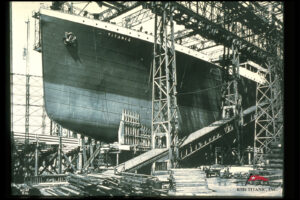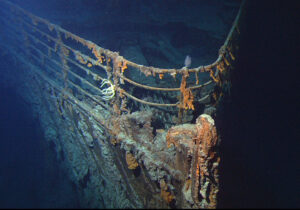Who Built the Titanic? The Story Behind Its Construction
The Titanic’s story is one of ambition, innovation, and tragedy. While many know of its ill-fated journey, fewer are aware of the remarkable efforts that went into building it. Together, we’ll explore the creators of the Titanic, the famous shipyard of Harland and Wolff, and the meticulous construction process. We’ll also highlight the preservation initiatives led by RMS Titanic Inc., who work tirelessly to ensure the Titanic’s story continues to be told.
The Visionaries: Who Conceived the Titanic?

The idea for the Titanic came from J. Bruce Ismay and William Pirrie. J. Bruce Ismay was the Chairman of the White Star Line, a prominent British shipping company. William Pirrie was the Chairman of Harland and Wolff, a leading shipbuilding company in Belfast, Ireland. Their collaboration aimed to create the largest and most luxurious ship ever built. They wanted to offer an unparalleled travel experience, combining size, speed, and luxury.
Building the Titanic: Harland and Wolff Shipyard
The Titanic was constructed at the Harland and Wolff shipyard in Belfast. Harland and Wolff had a reputation for building high-quality ships. Founded in 1861, the shipyard became one of the world’s largest shipbuilders. The decision to build the Olympic-class liners, including the Titanic, marked a significant milestone for the company. These ships were designed to compete with Cunard Line’s Lusitania and Mauretania.
Designing a Marvel: The Engineering Behind the Titanic
Thomas Andrews, a naval architect at Harland and Wolff, led the Titanic’s design. The ship featured advanced safety measures, including watertight compartments and remotely activated watertight doors. These features gave the Titanic the reputation of being “unsinkable.” The ship was 882 feet long and 175 feet high, making it the largest vessel of its time. The design also included luxurious amenities like a swimming pool, a squash court, and a grand staircase.
From Blueprint to Reality: Constructing the Titanic

Construction of the Titanic began with the laying of the keel in March 1909. The workforce included thousands of skilled laborers, engineers, and craftsmen. They worked tirelessly to bring the design to life. The construction process involved assembling the hull, installing the engines, and fitting out the interiors. Key milestones included the installation of the massive reciprocating engines and the turbine engine, which provided the ship’s propulsion.
A Grand Launch: The Titanic’s Debut
The Titanic was launched on May 31, 1911. The launch ceremony was a grand event, attended by thousands of spectators. The ship was then towed to a fitting-out berth, where workers installed the interiors and final touches. This process took nearly a year. The ship was finally ready for its maiden voyage in April 1912. The launch marked the culmination of years of planning and hard work.
The Titanic’s Design Tested: The Sinking

When the Titanic struck an iceberg on April 14, 1912, its design faced an ultimate test. The ship’s hull sustained multiple breaches below the waterline. Water began flooding the watertight compartments. The Titanic’s designers had intended these compartments to contain flooding. However, the damage spanned five compartments, exceeding the ship’s capacity to stay afloat.
The ship’s design included 16 watertight compartments. These compartments could be sealed off individually. This feature was meant to keep the ship stable even if some compartments flooded. Unfortunately, the bulkheads did not extend high enough. Water spilled over from one compartment to the next, creating a domino effect. The ship’s bow dipped lower into the water, accelerating the flooding.
The crew and engineers worked tirelessly to manage the flooding. Chief Engineer Joseph Bell and his team tried to maintain power and keep pumps running. They understood the ship’s layout and machinery intimately. Despite their efforts, the volume of incoming water overwhelmed their attempts. The design, though advanced for its time, could not cope with the extent of the damage. The sinking of the Titanic highlighted the limitations and vulnerabilities in its construction.
Legacy and Impact: Harland and Wolff’s Contribution
Harland and Wolff’s contribution to maritime engineering extended beyond the Titanic. The shipyard built many other significant vessels, including the Britannic and the Olympic, Titanic’s sister ships. The Titanic’s construction showcased the shipyard’s expertise and innovation. Today, Harland and Wolff’s legacy continues, with the shipyard still operational and contributing to the maritime industry. The company’s role in building the Titanic remains a proud part of its history.
Preserving History: The Role of RMS Titanic Inc.

RMS Titanic Inc. plays a vital role in preserving the Titanic’s history. The organization conducts research and expeditions to explore the wreck site. Their work helps to uncover new information about the ship and its tragic sinking. By preserving artifacts and sharing findings, RMS Titanic Inc. ensures that the story of the Titanic remains alive for future generations. Their efforts contribute to a deeper understanding of this historic event.
Uncovering the Wreck: Key Discoveries by RMS Titanic Inc.
RMS Titanic Inc. has made significant discoveries during its expeditions. These include artifacts like personal items, ship components, and documents. The organization uses advanced technology, including underwater photography and remotely operated vehicles (ROVs), to explore the wreck site. These discoveries provide valuable insights into the Titanic’s construction, its final moments, and the lives of those on board. The images and data collected help researchers piece together the ship’s story.
Looking Ahead: The 2024 Titanic Expedition
In 2024, RMS Titanic Inc. will embark on a new expedition to the Titanic wreck site. The goals include taking new high-resolution photos and identifying more artifacts. The team will use the latest technology, including advanced ROVs and imaging equipment. This expedition aims to document the current state of the wreck and gather data for ongoing research. The mission will help preserve the Titanic’s legacy and contribute to maritime history.
Support RMS Titanic Inc. Today
The story of who built the Titanic involves visionary leaders, skilled shipbuilders, and innovative designers. The Harland and Wolff shipyard in Belfast played a crucial role in bringing the Titanic to life. The ship’s construction showcased the pinnacle of early 20th-century engineering and design.
RMS Titanic Inc. continues to uncover and preserve the ship’s history, ensuring that the legacy of the Titanic remains vibrant. Their ongoing research and upcoming 2024 expedition promise to reveal even more about this iconic vessel. Follow and support their mission to keep the story of the Titanic alive for future generations.
